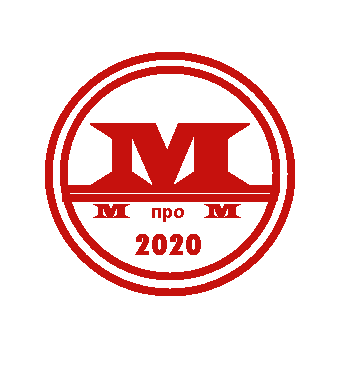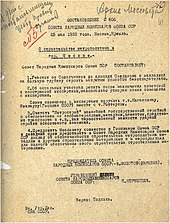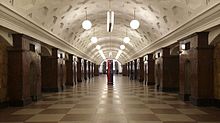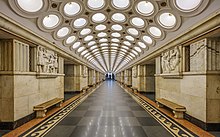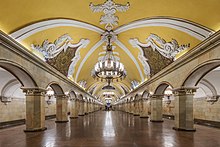
Scheme of development of the Moscow metro from 1935 to 2019
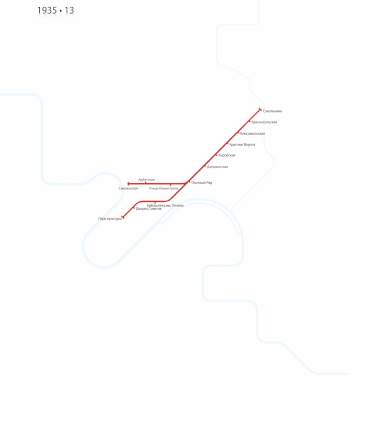
Basic information
Soviet government resolution to construct the Moscow Metro
The first plans for a metro system in Moscow date back to the Russian Empire but were postponed by World War I, the October Revolution and the Russian Civil War. In 1923, the Moscow City Council formed the Underground Railway Design Office at the Moscow Board of Urban Railways. It carried out preliminary studies, and by 1928 had developed a project for the first route from Sokolniki to the city centre. At the same time, an offer was made to the German company Siemens Bauunion to submit its own project for the same route. In June 1931, the decision to begin construction of the Moscow Metro was made by the Central Committee of the Communist Party of the Soviet Union. In January 1932 the plan for the first lines was approved, and on 21 March 1933 the Soviet government approved a plan for 10 lines with a total route length of 80 km (50 mi).
The first lines were built using the Moscow general plan designed by Lazar Kaganovich, along with his project managers (notably Ivan M. Kuznetsov and, later, Isaac Y. Segal) in the 1930s–1950s, and the Metro was named after him until 1955 (Metropoliten im. L.M. Kaganovicha). The Moscow Metro construction engineers consulted with their counterparts from the London Underground, the world’s oldest metro system, in 1936: British architect Charles Holden and administrator Frank Pick had been working on the station developments of the Piccadilly Line extension, and Soviet delegates to London were impressed by Holden’s thoroughly modern redeployment of classical elements and use of high-quality materials for the circular ticket hall of Piccadilly Circus, and so engaged Pick and Holden as advisors to Moscow’s metro system. Partly because of this connection, the design of Gants Hill tube station, which was completed in 1947, is reminiscent of a Moscow Metro station. Indeed, Holden’s homage to Moscow has been described as a gesture of gratitude for the USSR’s helpful role in The Second World War.
Soviet workers did the labour and the art work, but the main engineering designs, routes, and construction plans were handled by specialists recruited from London Underground. The British called for tunnelling instead of the «cut-and-cover» technique, the use of escalators instead of lifts, the routes and the design of the rolling stock. The paranoia of the NKVD was evident when the secret police arrested numerous British engineers for espionage because they gained an in-depth knowledge of the city’s physical layout. Engineers for the Metropolitan-Vickers Electrical Company (Metrovick) were given a show trial and deported in 1933, ending the role of British business in the USSR.
Sokolniki station, Line 1. Opened in 1935 (the first stage)
Krasnye Vorota, also opened in 1935 (the first stage) as part of Sokolnicheskaya line, e.g. Line 1
The first line was opened to the public on 15 May 1935 at 07:00 am. It was 11 kilometres (6.8 mi) long and included 13 stations. The day was celebrated as a technological and ideological victory for socialism (and, by extension, Stalinism). An estimated 285,000 people rode the Metro at its debut, and its design was greeted with pride; street celebrations included parades, plays and concerts. The Bolshoi Theatre presented a choral performance by 2,200 Metro workers; 55,000 colored posters (lauding the Metro as the busiest and fastest in the world) and 25,000 copies of «Songs of the Joyous Metro Conquerors» were distributed. This publicity barrage, produced by the Soviet government, stressed the superiority of the Moscow Metro over all metros in capitalist societies and the Metro’s role as a prototype for the Soviet future. The Moscow Metro averaged 47 km/h (29 mph) and had a top speed of 80 km/h (50 mph). In comparison, New York City Subway trains averaged a slower 25 miles per hour (40 km/h) and had a top speed of 45 miles per hour (72 km/h). While the celebration was an expression of popular joy it was also an effective propaganda display, legitimizing the Metro and declaring it a success.
The initial line connected Sokolniki to Okhotny Ryad then branching to Park Kultury and Smolenskaya. The latter branch was extended westwards to a new station (Kiyevskaya) in March 1937, the first Metro line crossing the Moskva River over the Smolensky Metro Bridge.
The second stage was completed before the war. In March 1938, the Arbatskaya branch was split and extended to the Kurskaya station (now the dark-blue Arbatsko-Pokrovskaya Line). In September 1938, the Gorkovskaya Line opened between Sokol and Teatralnaya. Here the architecture was based on that of the most popular stations in existence (Krasniye Vorota, Okhotnyi Ryad and Kropotkinskaya); while following the popular art-deco style, it was merged with socialist themes. The first deep-level column station Mayakovskaya was built at the same time.
Building work on the third stage was delayed (but not interrupted) during World War II, and two Metro sections were put into service; Teatralnaya–Avtozavodskaya (three stations, crossing the Moskva River through a deep tunnel) and Kurskaya–Partizanskaya (four stations) were inaugurated in 1943 and 1944 respectively. War motifs replaced socialist visions in the architectural design of these stations. During the Siege of Moscow in the fall and winter of 1941, Metro stations were used as air-raid shelters; the Council of Ministers moved its offices to the Mayakovskaya platforms, where Stalin made public speeches on several occasions. The Chistiye Prudy station was also walled off, and the headquarters of the Air Defence established there.
After the war ended in 1945, construction began on the fourth stage of the Metro, which included the Koltsevaya Line, a deep part of the Arbatsko-Pokrovskaya line from Ploshchad Revolyutsii to Kievskaya and a surface extension to Pervomaiskaya during the early 1950s. The decoration and design characteristic of the Moscow Metro is considered to have reached its zenith in these stations. The Koltsevaya Line was first planned as a line running under the Garden Ring, a wide avenue encircling the borders of Moscow’s city centre. The first part of the line – from Park Kultury to Kurskaya (1950) – follows this avenue. Plans were later changed and the northern part of the ring line runs 1–1.5 kilometres (0.62–0.93 mi) outside the Sadovoye Koltso, thus providing service for seven (out of nine) rail terminals. The next part of the Koltsevaya Line opened in 1952 (Kurskaya–Belorusskaya), and in 1954 the ring line was completed.
Mayakovskaya station. Opened in 1938 (the second stage)
When the Metro opened in 1935, it immediately became the centrepiece of the transportation system (as opposed to horse-carried barrows still widely used in 1930s Moscow). It also became the prototype, the vision for future Soviet large-scale technologies. The artwork of the 13 original stations became nationally and internationally famous. For example, the Sverdlov Square subway station featured porcelain bas-reliefs depicting the daily life of the Soviet peoples, and the bas-reliefs at the Dynamo Stadium sports complex glorified sports and physical prowess on the powerful new «Homo Sovieticus« (Soviet man). The metro was touted as the symbol of the new social order—a sort of Communist cathedral of engineering modernity.
The Metro was also iconic for showcasing Socialist Realism in public art. The method was influenced by Nikolay Chernyshevsky, Lenin‘s favorite 19th-century nihilist, who stated that «art is no useful unless it serves politics». This maxim sums up the reasons why the stations combined aesthetics, technology and ideology: any plan which did not incorporate all three areas cohesively was rejected.
- Kaganovich was in charge; he designed the subway so that citizens would absorb the values and ethos of Stalinist civilization as they rode. Without this cohesion, the Metro would not reflect Socialist Realism. If the Metro did not utilize Socialist Realism, it would fail to illustrate Stalinist values and transform Soviet citizens into socialists. Anything less than Socialist Realism’s grand artistic complexity would fail to inspire a long-lasting, nationalistic attachment to Stalin’s new society.
- Socialist Realism was in fact a method, not exactly a style.
Elektrozavodskaya station. Opened in 1944 (the third stage)
The Moscow Metro was one of the USSR’s most ambitious architectural projects. The metro’s artists and architects worked to design a structure that embodied svet (literally «light», figuratively «radiance» or «brilliance») and svetloe budushchee (a well-lit/radiant/bright future). With their reflective marble walls, high ceilings and grand chandeliers, many Moscow Metro stations have been likened to an «artificial underground sun».
This palatial underground environment reminded Metro users their taxes were spent on materializing «radiant future»; also, the design was useful for demonstrating the extra structural strength of the underground works (as in Metro doubling as bunkers, bomb shelters).
The chief lighting engineer was Abram Damsky, a graduate of the Higher State Art-Technical Institute in Moscow. By 1930 he was a chief designer in Moscow’s Elektrosvet Factory, and during World War II was sent to the Metrostroi (Metro Construction) Factory as head of the lighting shop. Damsky recognized the importance of efficiency, as well as the potential for light as an expressive form. His team experimented with different materials (most often cast bronze, aluminum, sheet brass, steel, and milk glass) and methods to optimize the technology. Damsky’s discourse on «Lamps and Architecture 1930–1950» describes in detail the epic chandeliers installed in the Taganskaya Station and the Kaluzhskaia station (Oktyabrskaya nowadays, not to be confused with contemporary «Kaluzhskaya» station on line 6).
The Kaluzhskaya Station was designed by the architect [Leonid] Poliakov. Poliakov’s decision to base his design on a reinterpretation of Russian classical architecture clearly influenced the concept of the lamps, some of which I planned in collaboration with the architect himself. The shape of the lamps was a torch – the torch of victory, as Polyakov put it… The artistic quality and stylistic unity of all the lamps throughout the station’s interior made them perhaps the most successful element of the architectural composition. All were made of cast aluminum decorated in a black and gold anodized coating, a technique which the Metrostroi factory had only just mastered.
The Taganskaia Metro Station on the Ring Line was designed in…quite another style by the architects K.S. Ryzhkov and A. Medvedev… Their subject matter dealt with images of war and victory…The overall effect was one of ceremony … In the platform halls the blue ceramic bodies of the chandeliers played a more modest role, but still emphasised the overall expressiveness of the lamp.
— Abram Damsky, Lamps and Architecture 1930–1950
The work of Abram Damsky further publicized these ideas hoping people would associate the party with the idea of bright future.
Statue representing the Soviet workers at Baumanskaya station
Stalin’s first five-year plan (1928–1932) facilitated rapid industrialization to build a socialist motherland. The plan was ambitious, seeking to reorient an agrarian society towards industrialism. It was Stalin’s fanatical energy, large-scale planning, and resource distribution that kept up the pace of industrialization. The first five-year plan was instrumental in the completion of the Moscow Metro; without industrialization, the Soviet Union would not have had the raw materials necessary for the project. For example, steel was a main component of many subway stations. Before industrialization, it would have been impossible for the Soviet Union to produce enough steel to incorporate it into the metro’s design; in addition, a steel shortage would have limited the size of the subway system and its technological advancement.
The Moscow Metro furthered the construction of a socialist Soviet Union because the project accorded with Stalin’s second five-year plan. The Second Plan focused on urbanization and the development of social services. The Moscow Metro was necessary to cope with the influx of peasants who migrated to the city during the 1930s; Moscow’s population had grown from 2.16 million in 1928 to 3.6 million in 1933. The Metro also bolstered Moscow’s shaky infrastructure and its communal services, which hitherto were nearly nonexistent.
Monument to Soviet partisan Zoya Kosmodemyanskaya at the Partizanskaya station from 1944
The Communist Party had the power to mobilize; because the party was a single source of control, it could focus its resources. The most notable example of mobilization in the Soviet Union occurred during World War II. The country also mobilized in order to complete the Moscow Metro with unprecedented speed. One of the main motivation factors of the mobilization was to overtake the West and prove that a socialist metro could surpass capitalist designs. It was especially important to the Soviet Union that socialism succeed industrially, technologically, and artistically in the 1930s, since capitalism was at a low ebb during the Great Depression.
The person in charge of Metro mobilization was Lazar Kaganovich. A prominent Party member, he assumed control of the project as chief overseer. Kaganovich was nicknamed the «Iron Commissar»; he shared Stalin’s fanatical energy, dramatic oratory flare, and ability to keep workers building quickly with threats and punishment. He was determined to realise the Moscow Metro, regardless of cost. Without Kaganovich’s managerial ability, the Moscow Metro might have met the same fate as the Palace of the Soviets: failure.
Kiyevskaya (Line 3) (1954) is decorated with a series of mosaics by various artists depicting life in Ukraine which was then part of the Soviet Union.
This was a comprehensive mobilization; the project drew resources and workers from the entire Soviet Union. In his article, archeologist Mike O’Mahoney describes the scope of the Metro mobilization:
A specialist workforce had been drawn from many different regions, including miners from the Ukrainian and Siberian coalfields and construction workers from the iron and steel mills of Magnitogorsk, the Dniepr hydroelectric power station, and the Turkestan-Siberian railway… materials used in the construction of the metro included iron from Siberian Kuznetsk, timber from northern Russia, cement from the Volga region and the norther Caucasus, bitumen from Baku, and marble and granite from quarries in Karelia, the Crimea, the Caucasus, the Urals, and the Soviet Far East
— Mike O’Mahoney, Archeological Fantasies: Constructing History on the Moscow Metro
Skilled engineers were scarce, and unskilled workers were instrumental to the realization of the metro. The Metrostroi (the organization responsible for the Metro’s construction) conducted massive recruitment campaigns. It printed 15,000 copies of Udarnik metrostroia (Metrostroi Shock Worker, its daily newspaper) and 700 other newsletters (some in different languages) to attract unskilled laborers. Kaganovich was closely involved in the recruitment campaign, targeting the Komsomol generation because of its strength and youth.
Komsomolskaya station, opened in 1952, Line 5
The beginning of the Cold War led to the construction of a deep section of the Arbatsko-Pokrovskaya Line. The stations on this line were planned as shelters in the event of nuclear war. After finishing the line in 1953 the upper tracks between Ploshchad Revolyutsii and Kiyevskaya were closed, and later reopened in 1958 as a part of the Filyovskaya Line. The stations, too, were supplied with tight gates and life-sustenance systems to function as proper nuclear shelters.
In the further development of the Metro the term «stages» was not used any more, although sometimes the stations opened in 1957–1959 are referred to as the «fifth stage».
Leninskyie Gory, 1959, Line 1 (old photo from 1982)
Profsoyuznaya, 1962, Line 6 only has gray tiles
Kakhovskaya, 1969, Line 11 (before reconstruction)
During the late 1950s and throughout the 1960s, the architectural extravagance of new Metro stations was decisively rejected on the orders of Nikita Khrushchev. He had a preference for a utilitarian «minimalism»-like approach to design, similar to Brutalism style. The idea behind the rejection was similar to one used to create Khrushchyovkas: cheap yet easily mass-produced buildings. Stations of his era, as well as most 1970s stations, were simple in design and style, with walls covered with identical square ceramic tiles. Even decorations at the Metro stations almost finished at the time of the ban (such as VDNKh and Alexeyevskaya) got their final decors simplified: VDNKh’s arcs/portals, for example, got plain green paint to contrast with well-detailed decorations and pannos around them.
A typical layout of the cheap shallow-dug metro station (which quickly became known as Sorokonozhka – «centipede», from early designs with 40 concrete columns in two rows) was developed for all new stations, and the stations were built to look almost identical, differing from each other only in colours of the marble and ceramic tiles. Most stations were built with simpler, cheap technology; this resulted in utilitarian design being flawed in some ways. Some stations such as adjacent Rechnoi Vokzal and Vodny Stadion or sequiential Leninsky Prospect, Akadmicheskaya, Profsoyuznaya and Novye Cheryomushki would have a similar look due to the extensive use of same-sized white or off-white ceramic tiles with hard-to-feel differences.
Polezhayevskaya. Opened in 1972. As of January 2022, the variegated walls are preserved «as is»
Walls with cheap ceramic tiles were susceptible to train-related vibration: some tiles would eventually fall off and break. It was not always possible to replace the missing tiles with the ones of the exact color and tone, which eventually led to variegated parts of the walls.
The contrasting style gap between the powerfully decorated stations of Moscow’s centre and the spartan-looking stations of the 1960s was eventually filled. In the mid-1970s the architectural extravagance was partially restored. However, the newer design of shallow «centipede» stations (now with 26 columns, more widely spaced) continued to dominate. For example, Kaluzhskaya «centipede» station from 1974 (adjacent to Novye Cheryomushki station) features non-flat tiles (with 3D effect utilized), and Medvedkovo from 1978 features complex decorations.
Babushkinskaya station from 1978 is a no-column station (similar to Biblioteka Imeni Lenina from 1935). 1983 Chertanovskaya station has resemblance to Kropotkinskaya (from 1935). Some stations, such as the deep-dug Shabolovskaya (1980), have the near-tunnel walls decorated with metal sheets, not tiles. Downtown area got such stations as Borovitskaya (1986), with uncovered bricks and gray, concrete-like colors accompanying a single gold-plated decorative pane known as «Tree of peoples’ of USSR». Tyoply Stan features a theme related to the name and the location of the station («Tyoply Stan» used to literally mean warm area): its walls are covered in brick-colored ribbed panes, which look like radiators).
Metro stations of the 1990s and 2000s vary in style, but some of the stations seem to have their own themes:
- Ulitsa Akademika Yangelya station features thick orange neon lamp-like lights instead of regular white lights.
- Park Pobedy, the deepest station of the Moscow Metro, was built in 2003; it features extensive use of dark orange polished granite.
- Slavyansky Bulvar station utilizes a plant-inspired theme (not to be confused with subtle «bionic style»).
Kozhukhovskaya station (1995)
- The sleekness of aforementioned bionic style is somewhat represented in various Line 10 stations.
- Sretensky Bulvar station of line 10 is decorated with paintings of nearby memorials and locations.
- Strogino station has a theme of huge eye-shaped boundaries for lights; with «eyes» occupying the station’s ceiling.
- Troparyovo (2014) features trees made of polished metal. The trees hold the station’s diamond-shaped lights. The station, however, is noticeably dim-lit.
- Delovoy Tsentr (2016, MCC, overground station) has green tint.
- Lomonosovsky Prospekt (Line 8A) is decorated with various equations.
- Olkhovaya (2019) uses other plant-inspired themes («Olkha» means alder) with autumn/winter inspired colours.
Some bleak, bland-looking «centipedes» like Akademicheskaya and Yugo-Zapadnaya have undergone renovations in the 21st century (new blue-striped white walls on Akademicheskaya, aqualine glassy, shiny walls on Yugo-Zapadnaya).
Aminyevskaya with thin stripe themed design
After upgrading the railway from 1908 to a proper Metro line, the development of another circle line line was re-launched, now adjusted for the pear-shaped circle route #14.
Throughout the 2010s, Line 11 was extended from short, tiny Kakhovskaya line to a half-circle (from Kakhovskaya to Savyolovskaya, with a complete circle route line 11 projected for the 2020s.
- Similarly made Shelepikha, Khoroshovskaya, CSKA and Petrovsky Park stations have lots of polished granite and shiny surfaces, in contrast to Soviet «centipedes». Throughout 2018–2021, these stations were connected to line 8A.
- Narodnoye Opolcheniye (2021) features lots of straight edges and linear decorations (such as uninterrupted «three stripes» style of the ceiling lights and rectangular columns).
As for the spring of 2023, the whole circle route line is up and running, forming a circle stretching to the southern near-MKAD residential parts of the city (Prospekt Vernadskogo, Tekstilshchiki) as opposed to the MCC’s stretching towards the northern districts of Moscow. In other words, while the 70km long line 11 is still longer than Beijing’s circle route, it mirrors Line 14 rather than forming a perfect circle around the city centre.
